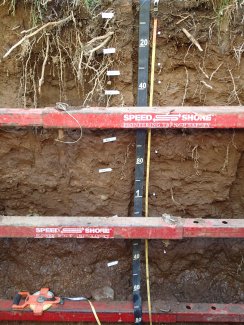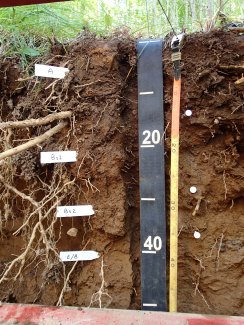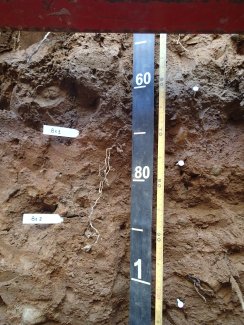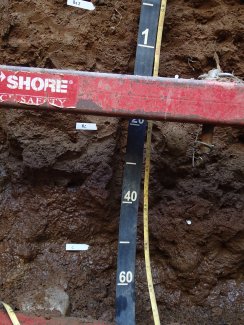Steigerwaldt-Chequamegon NEON (STEI) Soil Descriptions
Distributed Soils Reports
Pedon Descriptions
Pit‐level observations and field measurements reported using the standard NRCS format. They contain volume estimates for coarse fragments > 20 mm where applicable.
Site Level Plot Summary
A narrative summary that places the sampled soil pedons in the broader context of soils and geomorphology for the entire NEON site.
Megapit Images

D05 STEI megapit soil profile 0-180 cm

D05 STEI megapit soil profile 0-49 cm

D05 STEI megapit soil profile 50-105 cm

D05 STEI megapit soil profile 89-168 cm
Megapit Pedon Description
| Print Date | Feb 18 2016 |
|---|---|
| Description Date | Jun 17 2015 |
| Describer | Ryan Bevernitz, Phil Meyer, Scott Eversoll |
| Site ID | 2015WI069001 |
| Pedon ID | S2015WI069001 |
| Pedon Note | The soil gets coarser as the depth increases. |
| Lab Source ID | KSSL |
| Lab Pedon # | 15N0685 |
| Soil Name as Correlated | Pesabic |
| Classification | Coarse-loamy, mixed, superactive, frigid Alfic Epiaquods |
| Pedon Type | undefined observation |
| Pedon Purpose | ecological site data |
| Taxon Kind | series |
| Geomorphic Setting | on shoulder of moraine on pitted outwash plain |
| Description origin | NASIS |
| Country | United States |
| State | Wisconsin |
| County | Lincoln |
| MLRA | 94D -- Northern Highland Sandy Drift |
| Soil Survey Area | 10-RHI -- Rhinelander, Wisconsin |
| Map Unit | MxB -- Moodig sandy loam, 0 to 4 percent slopes |
| Std Latitude | 45.5074944 |
| Std Longitude | -89.5888861 |
| Latitude | 45 degrees 30 minutes 26.98 seconds north |
| Longitude | 89 degrees 35 minutes 19.99 seconds west |
| Datum | NAD83 |
| Primary Earth Cover | Tree cover |
| Secondary Earth Cover | Hardwoods |
| Existing Vegetation | balsam fir, baneberry, black raspberry, bunchberry dogwood, fly honeysuckle, goldenrod, hawkweed, ironwood, quaking aspen, red maple, sedge, shieldfern, starflower, white ash |
| Parent Material | sandy and loamy till |
| Description database | KSSL |
| Diagnostic Features | ochric epipedon 0 to 14 cm. spodic horizon 14 to 36 cm. glossic horizon 36 to 61 cm. argillic horizon 61 to 109 cm. densic materials 148 to 200 cm. |
| Top Depth (cm) | 148 |
| Bottom Depth (cm) | 200 |
| Restriction Kind | densic material |
| Slope (%) | 3.0 |
| Elevation (meters) | 473.5 |
| Aspect (deg) | 280 |
| Drainage Class | somewhat poorly |
| Horizon Details |
A--0 to 14 centimeters (0.0 to 5.5 inches); light brownish gray (10YR 6/2) silt loam; moderate medium granular structure; very friable; very fine roots and medium roots and fine roots and coarse roots; 5 percent nonflat subrounded indurated 2 to 75-millimeter mixed rock fragments; moderately acid, pH 5.8, Hellige-Truog; clear wavy boundary. Lab sample # 15N03525. 10 percent uncoated sand grains Bs1--14 to 28 centimeters (5.5 to 11.0 inches); dark brown (7.5YR 3/4) fine sandy loam; moderate medium subangular blocky structure; friable; very fine roots and medium roots and fine roots and coarse roots; 2 percent nonflat subrounded indurated 250 to 600-millimeter mixed rock fragments and 9 percent nonflat subrounded indurated 2 to 75-millimeter mixed rock fragments; strongly acid, pH 5.4, Hellige-Truog; clear smooth boundary. Lab sample # 15N03526 Bs2--28 to 36 centimeters (11.0 to 14.2 inches); brown (7.5YR 4/3) sandy loam; moderate medium subangular blocky structure; friable; very fine roots and medium roots and fine roots and coarse roots; 2 percent nonflat subrounded indurated 250 to 600-millimeter mixed rock fragments and 9 percent nonflat subrounded indurated 2 to 75-millimeter mixed rock fragments; strongly acid, pH 5.5, Hellige-Truog; clear smooth boundary. Lab sample # 15N03527 E/B--36 to 61 centimeters (14.2 to 24.0 inches); 55 percent brown (7.5YR 5/3) and 45 percent brown (7.5YR 4/3) gravelly sandy loam; strong coarse subangular blocky structure; friable; very fine roots and medium roots and fine roots; 10 percent medium distinct 7.5YR 4/6), moist, masses of oxidized iron and 10 percent fine distinct 7.5YR 5/2), moist, clay depletions; 5 percent nonflat subrounded indurated 250 to 600-millimeter mixed rock fragments and 10 percent nonflat subrounded indurated 2 to 75-millimeter mixed rock fragments; strongly acid, pH 5.3, Hellige-Truog; clear wavy boundary. Lab sample # 15N03528 Bt1--61 to 78 centimeters (24.0 to 30.7 inches); dark brown (7.5YR 3/4) gravelly sandy loam; moderate coarse subangular blocky structure; friable; very fine roots and medium roots and fine roots; 10 percent faint 7.5YR 3/3), moist, clay films on all faces of peds; 25 percent coarse prominent 5YR 5/8), moist, masses of oxidized iron and 25 percent medium distinct 7.5YR 5/2), moist, clay depletions; 25 percent nonflat subrounded indurated 2 to 75-millimeter mixed rock fragments; strongly acid, pH 5.3, Hellige-Truog; gradual wavy boundary. Lab sample # 15N03529 Bt2--78 to 109 centimeters (30.7 to 42.9 inches); brown (7.5YR 4/4) gravelly sandy loam; weak medium subangular blocky structure; friable; very fine roots and medium roots and fine roots; 10 percent faint 7.5YR 4/3), moist, clay films on all faces of peds; 1 percent medium prominent 10Y 6/), moist, clay depletions and 25 percent coarse prominent 5YR 4/6), moist, and 7.5YR 5/8), moist, masses of oxidized iron and 25 percent medium prominent 2.5Y 6/2), moist, clay depletions; 5 percent nonflat subrounded indurated 75 to 250-millimeter mixed rock fragments and 15 percent nonflat subrounded indurated 2 to 75-millimeter mixed rock fragments; moderately acid, pH 5.7, Hellige-Truog; gradual wavy boundary. Lab sample # 15N03530. pockets of silt loam with redox throught. BC--109 to 148 centimeters (42.9 to 58.3 inches); brown (7.5YR 4/4) very gravelly sandy loam; weak medium subangular blocky structure; friable; very fine roots and medium roots and fine roots; 10 percent medium prominent 5YR 5/3), moist, clay depletions and 10 percent medium prominent 5YR 4/6), moist, masses of oxidized iron; 15 percent nonflat subrounded indurated 75 to 250-millimeter mixed rock fragments and 20 percent nonflat subrounded indurated 2 to 75-millimeter mixed rock fragments; moderately acid, pH 5.9, Hellige-Truog; clear wavy boundary. Lab sample # 15N03531 Cd--148 to 200 centimeters (58.3 to 78.7 inches); reddish brown (5YR 4/3) gravelly sandy loam; structureless massive; firm; 10 percent coarse prominent 10YR 5/2), moist, clay depletions and 25 percent very coarse prominent 5YR 4/6), moist, masses of oxidized iron; 2 percent nonflat subrounded indurated 250 to 600-millimeter mixed rock fragments and 5 percent nonflat subrounded indurated 75 to 250-millimeter mixed rock fragments and 15 percent nonflat subrounded indurated 2 to 75-millimeter mixed rock fragments; slightly acid, pH 6.2, Hellige-Truog. Lab sample # 15N03532 |
Credits: This megapit soil pedon description was generously created by USDA Natural Resource Conservation Service staff, with particular thanks to Larry West, Jon Hempel, and numerous field staff.